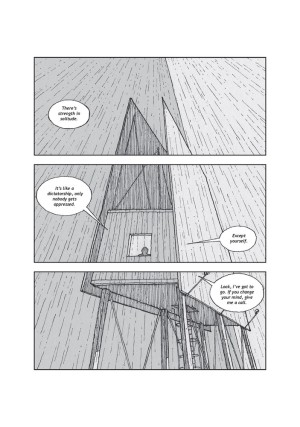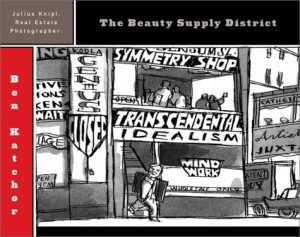Review by Jamie McNeil
Originally self-published in a six volume format, Owen D. Pomery’s long-form debut is an exceptional look at isolation and loneliness; how it is possible even in a sea of people. This book format adds other work and commentaries by the author in The Authoring of Architecture, effectively two books for the price of one.
Between the Billboards follows James Ebner, a man who has intentionally isolated himself in a converted space between two buildings, high above an unspecified city. Other than coming down to buy sundries (cigarettes, gin, food) or other find other necessities (sex), Eb (as he is known to his friends) only visits Benson’s Bar- Cafe and Eric’s Bowling Alley. His friend Israel is his only other connection to the real world, the sole person to visit and try and convince Eb live life again. We don’t know why Eb has chosen to live there, but it is clear that he is methodically and systematically severing every connection to the world below him.
An architect by profession, Pomery lays out his frames in meticulous order. Entirely in black and white, his drawings are measured and precise, simplistically detailed to enhance the feeling of isolation and emotion. His best technique is to present every frame as a different perspective. For instance, Pomery draws a full-page aerial view of Eb’s home between the billboards and the high-rise buildings surrounding it that are skilfully presented over anything from three to nine frames. Such is the technique that you can study them one at a time or hold the book in front of you to view it in its entirety. It is visually innovative, exciting, and absolutely bloody brilliant to behold.
Between the Billboards’ dialogue is of a fairly philosophical nature, allowing us to look into Eb’s world and witness his growing self-isolation. Pomery suggests through flashbacks that a broken-heart may be part of the reason, but no more is suggested. The reader is left to make their own opinions, although clear understanding is hindered by an uncertainty as to who is actually saying what. Is this a commentary on selfishness, mental health, the decline of community? Is it a call to look around us and become aware of the pandemic of loneliness in modern society? It may be all or none of these, but whatever it is charts a tragically bleak withdrawal from community and all that binds us to it.
The Authoring of Architecture collects some of Pomery’s shorter works that have featured in newspapers, periodicals, or magazines interspersed with musings on how his architectural background influences his cartoon style. The length of each offering varies from four frames to four pages, from perspectives inside his own house to musing on the seeming infinity of a cornfield. It is the elegant simplicity of his work that is simultaneously art and social commentary. The generally lighter tone offsets the bleakness of Between the Billboards, helped by the scenes of interactions between a customer and the proprietor of Benson’s. These appear at various points throughout and showcase a talent for incredibly intelligent plotting skills, the ending itself ingenious.
This neat little book can be collected for a number of reasons: brilliant artwork, intelligent narrative, or just because having it on your shelf makes you feel incredibly sophisticated and socially aware. Above all, it highlights the power of graphic novels to deliver thought-provoking observations on society where other mediums would fail.





